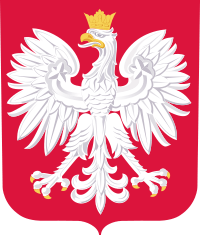Economy of Poland
The economy of Poland is the sixth largest in the European Union (EU) and the largest among the former Eastern Bloc members of the EU.[26] Since 1990, Poland has pursued a policy of economic liberalization and its economy was the only one in the EU to avoid a recession through the 2007–08 economic downturn.[27] As of 2019 the Polish economy has been growing steadily for the past 28 years, a record high in the EU and only surpassed by Australia in the world economy.[28] GDP per capita at purchasing power parity has grown on average by 6% p.a. over the last 20 years, the most impressive performance in Central Europe resulting in the country increasing its GDP seven-fold since 1990.[29]
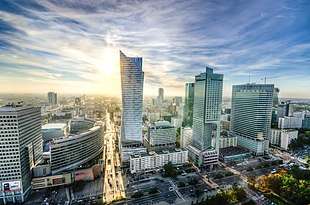 | |
| Currency | Złoty (PLN, zł) |
|---|---|
| Calendar year | |
Trade organisations | EU, WTO and OECD |
Country group | |
| Statistics | |
| Population | |
| GDP | |
| GDP rank | |
GDP growth |
|
GDP per capita | |
GDP per capita rank | |
GDP by sector |
|
Population below poverty line | |
Labour force | |
Labour force by occupation |
|
| Unemployment | |
Average gross salary | PLN 5,285 / €1,200 / $1,394 monthly (April, 2020) |
Average net salary | PLN 3,813 / €864 / $1,006 monthly (April, 2020) |
Main industries |
|
| External | |
| Exports | |
Export goods |
|
Main export partners |
|
| Imports | |
Import goods |
|
Main import partners |
|
FDI stock | |
Gross external debt | |
| Public finances | |
| Revenues | 41.3% of GDP (2019)[19] |
| Expenses | 42.0% of GDP (2019)[19] |
| Economic aid |
|
Foreign reserves | |
Poland is classified as a high-income economy by the World Bank[30] and ranks 21st worldwide in terms of GDP (nominal) as well as 24th in the 2017 Ease of Doing Business Index. Poland has a highly diverse economy that ranks 21st in the 2016 Economic Complexity Index. The largest component of its economy is the service sector (62.3.%), followed by industry (34.2%) and agriculture (3.5%). With the economic reform of 1989 the Polish external debt increased from $42.2 billion in 1989 to $365.2 billion in 2014. Poland shipped US$224.6 billion worth of goods around the globe in 2017, while exports increased to US$221.4 billion. The country's top export goods include machinery, electronic equipment, vehicles, furniture, and plastics.
According to the Statistics Poland, in 2010 the Polish economic growth rate was 3.7%, which was one of the best results in Europe. In 2014 its economy grew by 3.3% and in 2015 by 3.8%. Although in 2016 economic growth slowed, government stimulus measures combined with a tighter labour market in late 2016 kick-started new growth, which in 2017 the Polish Central Statistics Office states to be 5.2%.[31]
On 29 September 2017, the index provider FTSE Russell changed Poland's market status from an emerging market to a developed market.[3]
History
Poland has seen the largest increase in GDP per capita (more than 100%) both among the former Eastern Bloc countries, and compared to the EU-15 (around 45%).[32] It has had uninterrupted economic growth since 1992, even after the 2007 financial crisis.[33]
Before 1989
This article discusses the economy of the current Poland, post-1989. For historical overview of past Polish economies, see:
- Economy of the People's Republic of Poland (1945–1989)
- Economy of the Second Polish Republic (1918–1939)
- Economy of the Polish–Lithuanian Commonwealth (1569–1795)
1990-2009
The Polish state steadfastly pursued a policy of economic liberalization throughout the 1990s, with positive results for economic growth but negative results for some sectors of the population. The privatization of small and medium state-owned companies and a liberal law on establishing new firms has encouraged the development of the private business sector, which has been the main drive for Poland's economic growth. The agricultural sector remains handicapped by structural problems, surplus labor, inefficient small farms, and a lack of investment. Restructuring and privatization of "sensitive sectors" (e.g. coal), has also been slow, but recent foreign investments in energy and steel have begun to turn the tide. Recent reforms in health care, education, the pension system, and state administration have resulted in larger than expected fiscal pressures. Improving this account deficit and tightening monetary policy, with focus on inflation, are priorities for the Polish government. Further progress in public finance depends mainly on the reduction of public sector employment, and an overhaul of the tax code to incorporate farmers, who currently pay significantly lower taxes than other people with similar income levels.
Since the 2009 financial crisis
Since the global recession of 2009, Poland's GDP continued to grow. In 2009, at the high point of the crisis, the GDP for the European Union as a whole dropped by 4.5% while Polish GDP increased by 1.6%. As of November 2013, the size of EU's economy remains below the pre-crisis level, while Poland's economy increased by a cumulative 16%. The major reasons for its success appear to be a large internal market (in terms of population is sixth in EU) and a business friendly political climate. The economic reforms implemented after the fall of socialism in the 1990s have also played a role; between 1989 and 2007 Poland's economy grew by 177%, faster than other countries in Eastern and Central Europe, while at the same time millions were left without work.[33]
However, the economic fluctuations of the business cycle did affect Poland's unemployment rate, which by early 2013 reached almost 11%. This level was still below European average and has begun falling subsequently.[34] As of October 2017, Poland's unemployment rate stood at 4.6% according to Eurostat.[35]
Economic nationalism and Repolonisation
Since 2015, under the Law and Justice (PiS) government, Poland has seen a growing wave of economic nationalism, with state-owned PZU in 2015 agreeing to buy a 25.3-percent stake in Alior Bank;[36][37] PZU, together with the Polish Development Fund, buying a 32.8% stake in Bank Pekao by UniCredit in 2017; state-owned PKN Orlen merging with its fellow state-run utility Energa in 2020; and further plans to take over smaller rival Lotos. The minister also suggested Poland should have greater control over the economy.[38][39][40]
Data
The following table shows the main economic indicators in 1980–2018. Inflation up to 2% is in green.[41]
| Year | GDP (in Bil. US$ PPP) |
GDP per capita (in US$ PPP) |
GDP growth (real) |
Inflation rate (in Percent) |
Unemployment (in Percent) |
Government debt (in % of GDP) |
|---|---|---|---|---|---|---|
| 1980 | 168.7 | 4,744 | n/a | n/a | ||
| 1981 | n/a | n/a | ||||
| 1982 | n/a | n/a | ||||
| 1983 | n/a | n/a | ||||
| 1984 | n/a | n/a | ||||
| 1985 | n/a | n/a | ||||
| 1986 | n/a | n/a | ||||
| 1987 | n/a | n/a | ||||
| 1988 | n/a | n/a | ||||
| 1989 | n/a | n/a | ||||
| 1990 | 6.3% | n/a | ||||
| 1991 | n/a | |||||
| 1992 | n/a | |||||
| 1993 | n/a | |||||
| 1994 | n/a | |||||
| 1995 | 48.7% | |||||
| 1996 | ||||||
| 1997 | ||||||
| 1998 | ||||||
| 1999 | ||||||
| 2000 | ||||||
| 2001 | ||||||
| 2002 | ||||||
| 2003 | ||||||
| 2004 | ||||||
| 2005 | ||||||
| 2006 | ||||||
| 2007 | ||||||
| 2008 | ||||||
| 2009 | ||||||
| 2010 | ||||||
| 2011 | ||||||
| 2012 | ||||||
| 2013 | ||||||
| 2014 | ||||||
| 2015 | ||||||
| 2016 | ||||||
| 2017 | ||||||
| 2018 | ||||||
| 2019 |
Labour market and wages

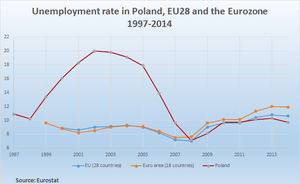
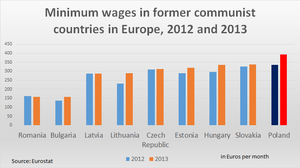
Unemployment in Poland appeared after the fall of socialism, although the economy previously had high levels of hidden unemployment. The unemployment rate then fell to 10% by the late 1990s and then increased again in the first few years of the 21st century, reaching a peak of 20% in 2002. It has since decreased, although unevenly. Since 2008 the unemployment rate in Poland has consistently been below European average.[42]
The rate fell below 8% in 2015 and[43] 3.2% in 2019[44] leading to a labor deficit.[45]
The International Monetary Fund forecasted Poland’s unemployment rate to increase to 9.919% in 2020, and stand at 8.032% in Dec 2021.[46]
Foreign trade and FDI
With the collapse of the rouble-based COMECON trade bloc in 1991, Poland reoriented its trade. As early as 1996, 70% of its trade was with EU members. Neighboring Germany is Poland's main trading partner today. Poland joined the European Union in May 2004. Before that, it fostered regional integration and trade through the Central European Free Trade Agreement (CEFTA), which included Hungary, the Czech Republic, Slovakia and Slovenia.
Poland is a founding member of the World Trade Organization.[47] As a member of the European Union, it applies the common external tariff to goods from other countries including the United States. Poland's major imports are capital goods needed for industrial retooling and for manufacturing inputs. The country's exports also include machinery, but are highly diversified. The most successful exports are furniture, foods,[48] motor boats, light planes, hardwood products, casual clothing, shoes and cosmetics.[49] Germany is by far the biggest importer of Poland's exports as of 2013.[50] In the agricultural sector, the biggest money-makers abroad include smoked and fresh fish, fine chocolate, and dairy products, meats and specialty breads,[51] with the exchange rate conducive to export growth.[52] Food exports amounted to 62 billion złoty in 2011, increasing by 17% from 2010.[53] Most Polish exports to the U.S. receive tariff benefits under the Generalized System of Preferences (GSP) program.
Poland is less dependent on external trade than most other Central and Eastern European countries, but its volume of trade with Europe is still substantial. In 2011 the volume of trade (exports plus imports) with the Euro area as share of GDP was 40%, a doubling from the mid 1990s. 30% of Poland's exports are to Germany and another 30% to the rest of Europe. There has been substantial increase in Poland's exports to Russia.[54] However, in August 2014, exports of fruits and vegetables to Russia fell dramatically following its politically motivated ban by Moscow.[55]
Foreign direct investment (FDI) was at 40% of GDP in 2010, a doubling over the level in 2000. Most FDI into Poland comes from France, Germany and Netherlands. Polish firms in turn have foreign investments primarily in Italy and Luxembourg. Most of the internal FDI is in manufacturing, which makes it susceptible to economic fluctuations in the source countries.[54]
The UAE has become Poland's largest trading partner in the Arab world, said Roman Chalaczkiewicz, Polish Ambassador to the UAE, speaking to Gulf News.[56]
The government offers investors various forms of state aid, such as: CIT tax at the level of 19% and investment incentives in 14 Special Economic Zones (among others: income tax exemption, real estate tax exemption, competitive land prices), several industrial and technology parks, the possibility to benefit from the EU structural funds, brownfield and greenfield locations. According to the National Bank of Poland (NBP) the level of FDI inflow into Poland in 2006 amounted to €13.9 billion.
According to an Ernst & Young report, Poland ranks 7th in the world in terms of investment attractiveness. However, Ernst & Young's 2010 European attractiveness survey reported that Poland saw a 52% decrease in FDI job creation and a 42% decrease in number of FDI projects since 2008.[57] According to the OECD (www.oecd.org) report, in 2004 Poles were one of the hardest working nations in Europe. Yet, the ability to establish and conduct business easily has been cause for economic hardship; the 2010 the World Economic Forum ranked Poland near the bottom of OECD countries in terms of the clarity, efficiency and neutrality of the legal framework used by firms to settle disputes.[58]
Sectors
Production industries
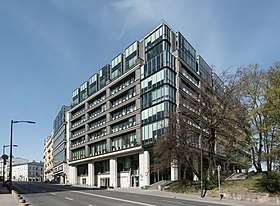

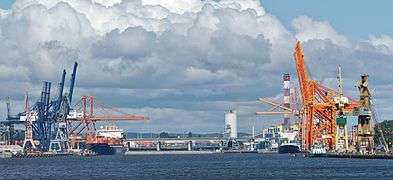
Before World War II, Poland's industrial base was concentrated in the coal, textile, chemical, machinery, iron, and steel sectors. Today it extends to fertilizers, petrochemicals, machine tools, electrical machinery, electronics, car manufacture and shipbuilding.
Poland's industrial base suffered greatly during World War II, and many resources were directed toward reconstruction. The socialist economic system imposed in the late 1940s created large and unwieldy economic structures[59] operated under a tight central command. In part because of this systemic rigidity, the economy performed poorly even in comparison with other economies in Central Europe.[59]
In 1990, the Tadeusz Mazowiecki government began a comprehensive reform programme to replace the centralised command economy with a market-oriented system. While the results overall have been impressive, many large state-owned industrial enterprises, particularly the rail, mining, steel, and defence sectors, have remained resistant to change and the downsizing required to survive in a market-based economy.[59]
Energy
Pharmaceutics
The total value of the Polish pharmacy market in 2008 was PLN 24.1bn, 11.5% more than in 2007.[60]
The non-prescription medicines market, which accounts for about one-third of the total market value, was worth PLN 7.5bn in 2008. This value includes drugs and non-drugs such as dietary supplements, cosmetics, dressings, dental materials, diagnostic tests and medical devices. The prescription medicines market was worth PLN 15.8bn.[61]
Agriculture
Agriculture employs 12.7% of the work force but contributes 3.8% to the gross domestic product (GDP), reflecting relatively low productivity. Unlike the industrial sector, Poland's agricultural sector remained largely in private hands during the decades of real socialist [sic] rule. Most of the former state farms are now leased to farmer tenants. Lack of credit is hampering efforts to sell former state farmland. Currently, Poland's 2 million private farms occupy 90% of all farmland and account for roughly the same percentage of total agricultural production. Farms are small—8 hectares on average—and often fragmented. Farms with an area exceeding 15 ha accounted for 9% of the total number of farms but cover 45% of total agricultural area. Over half of all farm households in Poland produce only for their own needs with little, if any, commercial sales.
Poland is a net exporter of processed fruit and vegetables, meat, and dairy products. Processors often rely on imports to supplement domestic supplies of wheat, feed grains, vegetable oil, and protein meals, which are generally insufficient to meet domestic demand. However, Poland is the leading EU producer of potatoes and rye and is one of the world's largest producers of sugar beets and triticale. Poland also is a significant producer of rapeseed, grains, hogs, and cattle. Poland is the sixth largest producer and exporter of apples in the entire world.[62]
Tourism
Poland, especially after joining the European Union in 2004, became a place frequently visited by tourists. Most tourist attractions in Poland are connected with natural environment, historic sites and cultural events. They draw millions of tourists every year from all around the world. According to Tourist Institute's data, Poland was visited by 15.7 million tourists in 2006, and by 15 million tourists in 2007,[63] out of the total number of 66.2 million foreign visitors.[64] In 2016 the number of arrivals to Poland amounted to 80.5 million. 17.5 million of this number are arrivals considered for tourism purposes (with at least one night's stay), making it the 16th most visited country in the world.[65] The most popular cities are Kraków, Warsaw, Gdańsk, Wrocław, Łódź, Poznań, Szczecin, Lublin, Toruń, Sopot, Zakopane and the Wieliczka Salt Mine. The best recreational destinations include Poland's Masurian Lake District, Baltic Sea coast, Tatra Mountains (the highest mountain range of Carpathians), Sudetes and Białowieża Forest. Poland's main tourist offers consist of sightseeing within cities and out-of-town historical monuments, business trips, qualified tourism, agrotourism, mountain hiking (trekking) and climbing among others.
Financial sector
The Polish banking sector is regulated by the Polish Financial Supervision Authority (PFSA).
While transforming the country to a market-oriented economy during 1992–97, the government privatized some banks, recapitalized the rest and introduced legal reforms that made the sector competitive. These reforms, and the health and relative stability of the sector, attracted a number of strategic foreign investors. At the beginning of 2009, Poland's banking sector had 51 domestic banks, a network of 578 cooperative banks and 18 branches of foreign-owned banks. In addition, foreign investors had controlling stakes in nearly 40 commercial banks, which made up 68% of the banking capital.[66] Banks in Poland reacted to the financial crisis of 2009 by restraining lending, raising interest rates, and strengthening balance sheets. Subsequently, the sector started lending again, with an increase of more than 4% expected in 2011.
Venture capital
The segment of the private equity market that finances early-stage high-risk companies, with the potential for fast growth, 130 active firms in Poland (as of March 2019). Between 2009 and 2019, these entities have invested locally in over 750 companies, an average of 9 companies per portfolio. Since 2016, new legal institutions have been established for entities implementing investments in enterprises in the seed or startup phase. In 2018, venture capital funds invested €178M in Polish startups (0.033% of GDP). As of March 2019, total assets managed by VC companies operating in Poland are estimated at €2.6B. The total value of investments of the Polish VC market is worth €209.2M.[67]
Transportation
Poland is served by an extensive network of railways. In most cities the main railway station is located near a city centre and is well connected to the local transportation system. The infrastructure is operated by Polish State Railways, part of state-run PKP Group. The rail network is very dense in western and northern Poland, while eastern part of the country is less developed. The capital city, Warsaw, has the country's only rapid transit system: the Warsaw Metro.
The most important airport in Poland is Warsaw 'Frederic Chopin' International Airport. Warsaw's airport is the main international hub for LOT Polish Airlines. In addition to Warsaw Chopin, Wrocław, Gdańsk, Katowice, Kraków and Poznań all have international airports. In preparation for the Euro 2012 football championships jointly hosted by Poland and Ukraine, a number of airports around the country were renovated and redeveloped. This included the building of new terminals with an increased number of jetways and stands at both Copernicus Airport in Wrocław and Lech Wałęsa Airport in Gdańsk.
Poland has 412,264 km (256,170 mi) of public roads overall. Polish public roads are grouped into categories related to administrative division, which include National roads, Voivodeship roads, Powiat roads and Gmina roads. Motorways and expressways are part of the national road network. As of 10 January 2020, there are 4000 km of motorways and expressways in use.[68]
Major companies in Poland
Selection from the list of 500 largest companies in Poland compiled by magazine Polityka.[69]
|
|
Currency
Budget and debt
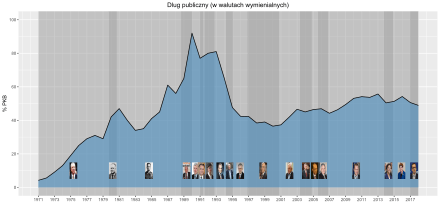
The public and private debt levels of Poland are below the European average (2017).
GDP growth in Poland
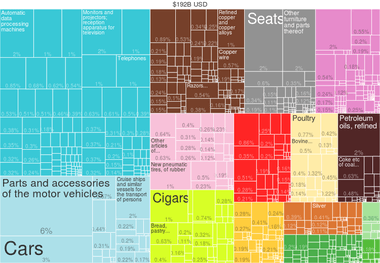
Recent GDP growth (comparing to the same quarter of previous year):[70]
| Year | Q1 | Q2 | Q3 | Q4 | Overall |
|---|---|---|---|---|---|
| 2019 | 4.7% | 4.1% | 4.1% | 3.2% | 4.1% |
| 2018 | 5.1% | 5.4% | 5.6% | 4.5% | 5.3% |
| 2017 | 4.4% | 4.3% | 5.2% | 4.3% | 4.9% |
| 2016 | 2.7% | 2.2% | 2.3% | 3.2% | 3.1% |
| 2015 | 3.9% | 3.4% | 3.8% | 4.2% | 3.8% |
| 2014 | 3.1% | 3.1% | 3.2% | 3.6% | 3.3% |
| 2013 | 0.1% | 1.3% | 1.7% | 2.2% | 1.4% |
| 2012 | 3.7% | 2.1% | 1.2% | 0.0% | 1.6% |
| 2011 | 5.2% | 5.1% | 5.1% | 4.8% | 5.0% |
| 2010 | 2.5% | 3.6% | 4.4% | 4.1% | 3.7% |
| 2009 | 2.1% | 1.9% | 2.0% | 4.1% | 2.6% |
| 2008 | 5.8% | 5.0% | 4.0% | 1.2% | 3.9% |
| 2007 | 7.5% | 7.5% | 6.4% | 7.4% | 7.2% |
| 2006 | 5.0% | 6.0% | 6.4% | 7.1% | 6.2% |
| 2005 | 3.1% | 2.3% | 4.7% | 4.0% | 3.5% |
| 2004 | 6.8% | 5.7% | 3.7% | 4.5% | 5.1% |
| 2003 | 2.0% | 3.8% | 4.1% | 4.3% | 3.6% |
| 2002 | 0.4% | 1.3% | 1.7% | 2.4% | 1.4% |
Location
Poland have a very good location for transporting locally made components or products to rest of Europe. For example, when moving production from China, the new factory in Poland can move their goods in 24 hours to most populated parts of Europe, and in 48 hours to all Europe.[71]
See also
- List of Polish voivodeships by GDP per capita
- Poland A and B
- Poverty in Poland
- Taxation in Poland
External links
- www.paiz.gov.pl
- Attractiveness Europe 2007
- The Polish economy in 2007 on YouTube
- Articles on Polish economy in Central and Eastern European Packaging magazine
- OECD's Poland country Web site and OECD Economic Survey of Poland
- Business Portal for Poland
- World Bank Summary Trade Statistics Poland
- Tariffs applied by Poland as provided by ITC's Market Access Map, an online database of customs tariffs and market requirements
References
- "World Economic Outlook Database, April 2019". IMF.org. International Monetary Fund. Archived from the original on 22 December 2019. Retrieved 29 September 2019.
- "World Bank Country and Lending Groups". datahelpdesk.worldbank.org. World Bank. Archived from the original on 28 October 2019. Retrieved 29 September 2019.
- "FTSE Russell upgrades Poland from emerging to developed market". thenews.pl. Archived from the original on 30 November 2018. Retrieved 25 March 2018.
- "Population on 31 December". ec.europa.eu/eurostat. GUS. Archived from the original on 19 October 2019. Retrieved 4 October 2019.
- "World Economic Outlook Database, October 2019". IMF.org. International Monetary Fund. Archived from the original on 23 December 2019. Retrieved 16 October 2019.
- "World Economic Outlook Database, April 2020". IMF.org. International Monetary Fund. Retrieved 20 May 2020.
- "Global Economic Prospects, June 2020". openknowledge.worldbank.org. World Bank. p. 80. Retrieved 16 June 2020.
- "The World Factbook". CIA.gov. Central Intelligence Agency. Archived from the original on 18 September 2015. Retrieved 4 February 2019.
- "Poverty headcount ratio at national poverty lines (% of population)". data.worldbank.org. World Bank. Archived from the original on 22 December 2019. Retrieved 21 March 2020.
- "People at risk of poverty or social exclusion". ec.europa.eu. Eurostat. Archived from the original on 13 August 2019. Retrieved 12 March 2020.
- "Gini coefficient of equivalised disposable income - EU-SILC survey". ec.europa.eu. Eurostat. Archived from the original on 20 March 2019. Retrieved 12 March 2020.
- "Human Development Index (HDI)". hdr.undp.org. HDRO (Human Development Report Office) United Nations Development Programme. Archived from the original on 15 December 2019. Retrieved 11 December 2019.
- "Inequality-adjusted HDI (IHDI)". hdr.undp.org. UNDP. Retrieved 22 May 2020.
- "Labor force, total - Poland". data.worldbank.org. World Bank. Archived from the original on 1 November 2019. Retrieved 1 November 2019.
- "Employment rate by sex, age group 20-64". ec.europa.eu/eurostat. Eurostat. Archived from the original on 13 August 2019. Retrieved 30 May 2019.
- "Unemployment by sex and age - monthly average". appsso.eurostat.ec.europa.eu. Eurostat. Archived from the original on 9 August 2019. Retrieved 2 July 2020.
- "Youth unemployment rate". data.oecd.org. OECD. Retrieved 3 April 2020.
- "Doing Business in Poland - World Bank Group". www.doingbusiness.org. Archived from the original on 10 April 2019. Retrieved 10 April 2019.
- "Euro area and EU27 government deficit both at 0.6% of GDP" (PDF). ec.europa.eu/eurostat. Eurostat. Retrieved 28 April 2020.
- "Archived copy" (PDF). Archived (PDF) from the original on 25 December 2017. Retrieved 25 December 2017.CS1 maint: archived copy as title (link)
- "Archived copy" (PDF). Archived (PDF) from the original on 20 April 2017. Retrieved 25 December 2017.CS1 maint: archived copy as title (link)
- "S&P keeps Poland's rating, outlook unchanged". thenews.pl. Archived from the original on 26 December 2017. Retrieved 25 March 2018.
- "Moody's changes outlook on Poland's A2 issuer rating to stable from negative; affirms ratings". moodys.com. 12 May 2017. Archived from the original on 24 September 2017. Retrieved 25 March 2018.
- "Press Release". www.fitchratings.com. Archived from the original on 23 December 2017. Retrieved 25 March 2018.
- Scope Ratings (1 November 2019). "Scope affirms Poland's credit rating of A+ with a Stable Outlook". Scope Ratings. Archived from the original on 16 February 2019. Retrieved 1 November 2019.
- "Report for Selected Countries and Subjects". www.imf.org. Archived from the original on 8 July 2018. Retrieved 25 March 2018.
- Editorial, Reuters. "Poland was a". reuters.com. Archived from the original on 23 June 2018. Retrieved 25 March 2018.
- Shotter, James; Majos, Agata (9 October 2019). "Poland election: the unfinished counter-revolution". Financial Times. Archived from the original on 3 December 2019. Retrieved 9 October 2019.
- "'This is the golden age': eastern Europe's extraordinary 30-year revival". theguardian.com. 27 October 2019. Archived from the original on 10 December 2019. Retrieved 27 October 2019.
- "WDI 2017 Maps - Data". data.worldbank.org. Archived from the original on 23 June 2018. Retrieved 25 March 2018.
- Frączyk, Jacek (7 December 2017). "Wzrostem PKB Polska zostawia Europę daleko z tyłu. Najnowsze dane Eurostatu". money.pl. Archived from the original on 23 June 2018. Retrieved 25 March 2018.
- Piatkowski, Marcin. "How Poland Became Europe's Growth Champion: Insights from the Successful Post-Socialist Transition". brookings.edu. Archived from the original on 1 July 2018. Retrieved 25 March 2018.
- "The Next Economic Powerhouse? Poland - BusinessDay : News you can trust". businessdayonline.com. 5 July 2017. Archived from the original on 2 May 2019. Retrieved 25 March 2018.
- "Poland has employee's market: minister". thenews.pl. Archived from the original on 1 July 2018. Retrieved 25 March 2018.
- "File:Unemployment rates, seasonally adjusted, October 2017 (%) F2.png - Statistics Explained". ec.europa.eu. Archived from the original on 8 July 2018. Retrieved 25 March 2018.
- https://internationalbanker.com/finance/polands-top-insurer-buys-a-stake-in-alior-bank-with-more-of-the-same-to-follow/
- https://www.ft.com/content/f7283548-5cd1-11e7-b553-e2df1b0c3220
- https://www.reuters.com/article/poland-economy-companies/poland-should-aim-to-merge-state-run-companies-minister-idUSL5N2CF63H
- https://www.nasdaq.com/articles/pkn-ready-to-offer-concessions-after-eu-warning-on-lotos-bid-sources-2020-03-30
- https://www.economist.com/europe/2018/08/09/polands-government-wants-to-take-control-of-banking
- "Report for Selected Countries and Subjects". www.imf.org. Archived from the original on 24 December 2019. Retrieved 12 April 2019.
- "File:Unemployment rates, seasonally adjusted, October 2015.png - Statistics Explained". ec.europa.eu. Archived from the original on 27 December 2017. Retrieved 25 March 2018.
- "Unemployment statistics - Statistics Explained". ec.europa.eu. Archived from the original on 14 March 2016. Retrieved 25 March 2018.
- "Unemployment in Bulgaria in November 2019 was 3.7% – Eurostat". The Sofia Globe staff o. Archived from the original on 13 January 2020. Retrieved 13 January 2020.
- Internet, JSK. "Poland facing risk of labor force deficit in 2015". msp.gov.pl. Archived from the original on 9 April 2018. Retrieved 25 March 2018.
- "Poland Forecast: Unemployment Rate [1990 - 2020] [Data & Charts]". www.ceicdata.com. Retrieved 20 May 2020.
- "Poland: June 2000". Trade Policy Reviews. World Trade Organization. 26 June 2000. Archived from the original on 1 July 2018. Retrieved 21 May 2014.
- PAP, 9 May 2013 Polska żywność - fundament polskiego eksportu - 2012 kolejnym rokiem rekordowego eksportu żywności. Ministerstwo Skarbu Państwa (Internet Archive).
- GUS, Najwięksi partnerzy handlowi Polski: kto kupuje nasze produkty? 9 July 2014 (Internet Archive)
- Ministerstwo Gospodarki, Polska - kierunki eksportu i najchętniej kupowane produkty z naszego kraju. 8 December 2013 Euro-Dane :: Ekonomia Unii Europejskiej (Internet Archive). Most important importers of Poland's 2012 exports, graph. Archived 6 November 2014 at the Wayback Machine Manifo.
- Patrycja Maciejewicz, Leszek Baj, Polska żywność jedzie w świat. Pełno niespodzianek 2012-04-07, Wyborcza.biz (Internet Archive).
- PAP, Więcej niż 80 proc. eksportu żywności z Polski to przetworzone produkty spożywcze 10-10-2014 Portal Spozywczy.pl (Internet Archive).
- Wiesław Łopaciuk, Padł rekord wartości eksportu produktów rolno-spożywczych z Polski. Powód: słaby złoty Rzeczpospolita, 27-01-2012 (Internet Archive). "Z analizy "Rzeczpospolitej" wynika, że łączna wartość eksportu produktów rolno-spożywczych Polski mogła w 2011 r. sięgnąć 62 mld zł. W porównaniu z 2010 r. była o niemal 17 proc. wyższa."
- Ho, Giang (July 2012). "Republic of Poland. Selected Issues" (PDF). IMF Country Report. 12 (163). Archived (PDF) from the original on 21 May 2014. Retrieved 21 May 2014.
- "Archived copy". Archived from the original on 22 October 2014. Retrieved 5 August 2014.CS1 maint: archived copy as title (link)
- UAEinteract.com. "UAE is Poland's largest Arab trading partner". Uaeinteract.com. Archived from the original on 17 September 2011. Retrieved 25 May 2011.
- Schwab, Klaus. "The Global Competitiveness Report 2010-2011" (PDF). World Economic Forum. Archived (PDF) from the original on 6 December 2010. Retrieved 25 April 2011.
- "Waking up to the new economy: Ernst & Young's 2010 European attractiveness survey" (PDF). Ernst & Young. Archived from the original (PDF) on 4 July 2010. Retrieved 25 April 2011.
- "Poland (11/07)". US Department of State. Archived from the original on 25 December 2019. Retrieved 25 September 2013.
- KPMG. "The Polish Pharmaceutical Market" (PDF). Yieldopedia. Archived (PDF) from the original on 12 June 2018. Retrieved 7 June 2018.
- "Polish pharmaceutical market". Pharmapoland.com. Archived from the original on 3 September 2011. Retrieved 25 May 2011.
- Top 10 apple-producing countries in the world. Archived 9 March 2016 at the Wayback Machine WhichCountry.co, General Knowledge.
- Information about tourism in Poland (in Polish). Archived 16 April 2013 at Archive.today Source: Instytut Turystyki, 2008.
- GUS (2008). "Przyjazdy do Polski (Foreign visits to Poland)". Statistics (in Polish). Instytut Turystyki. Archived from the original on 25 December 2012. Retrieved 31 December 2012.
- "International tourism, number of arrivals - Country Ranking". Archived from the original on 6 November 2017. Retrieved 28 October 2017.
- Wprost (9 November 2011). "Belka: polskie banki znów powinny być polskie". 70 proc. polskiego systemu bankowego jest własnościowo zdominowane przez banki zagraniczne. Biznes: Polityka i gospodarka, Wprost.pl. Archived from the original (Internet Archive) on 12 November 2014. Retrieved 12 November 2014.
w Polsce nie zbudowano by nowoczesnego systemu bankowego [bez akcjonariuszy zagranicznych, stwierdził Prezes NBP. Bez nich] Polska nie uniknęłaby kryzysu bankowego – Marek Belka, prezes Narodowego Banku Polskiego.
- Krysztofiak-Szopa, Julia; Wisłowska, Monika (2019). The Golden Book of Venture Capital in Poland 2019. Warsaw: Startup Poland. ISBN 978-83-948788-6-3. Archived from the original on 23 January 2020. Retrieved 13 June 2019.
- Boner, Błażej. "Od dziś w Polsce jest 4 tys. km dróg szybkiego ruchu. To dokładnie połowa tego, co zaplanowano". Archived from the original on 9 November 2019. Retrieved 13 January 2020.
- "500 largest companies in Poland". Lista500.polityka.pl. Polityka. Archived from the original on 24 May 2011. Retrieved 25 May 2011.
- "Quarterly National Accounts : Quarterly Growth Rates of real GDP, change over previous quarter". Stats.oecd.org. Archived from the original on 7 July 2018. Retrieved 1 June 2014.
- https://motoryzacja.interia.pl/wiadomosci/producenci/news-chinczycy-chca-produkowac-w-polsce,nId,4654105
- Worldmark Encyclopedia of National Economics, Volume 4 – Europe, Gale Group, 2002, ISBN 0-7876-4955-4
- Economic data from Eastern European Markets (ceeMarket.com)
